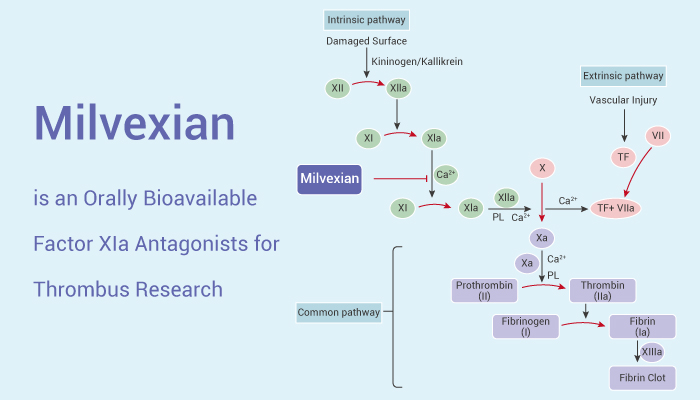Factor XIa (FXIa) is a serine protease involved in the coagulation cascade. Moreover, FXI knockout mice were found to be protected from arterial and venous thrombosis. Therefore, that FXIa inhibition can inhibit the pathophysiological formation of thrombus. And, FXIa relies on vitamin K synthesis in the liver, and inhibition of FXIa preserves normal hemostatic function. Here we introduce an FXIa inhibitor with antithrombotic efficacy, Milvexian.

Milvexian is an orally active factor XIa (FXIa) antagonist and antithrombotic agent.
Milvexian is a reversible factor Xia antagonist with Ki values of 0.11, 0.38, 0.64, 490, and 350 nM for humans, rabbits, dogs, rats, and mice, respectively. Firstly, it selectively inhibits FXIa in the intrinsic pathway of coagulation in a rabbit arteriovenous (AV) shunt model of venous thrombosis. And then, it dose-dependently inhibits venous thrombosis at doses of 0.25 + 0.17, 1.0 + 0.67, and 4.0 + 2.68 mg/kg. It also causes a dose-dependent prolongation of ex vivo activated partial thromboplastin time (aPTT). However,it has no effect on prothrombin time (PT) or thrombin time (TT). The rabbit AV shunt model of thrombosis is one of the classic animal models for characterizing anticoagulants/antithrombotic agents, which produces human pathological characteristics similar to venous thrombosis through an extracorporeal perfusion system. Vitamin K deficiency or Milvexian antagonism results in the production of inactive factor X, which has potential for use in anticoagulant therapy.
In summary, Milvexian prevents venous thrombosis in a rabbit model and is orally effective.
References:
[1] Pancras C, et al. J Thromb Haemost. 2022 Feb;20(2):399-408.
[2]. Xinkang Wang, et al. TH Open. 2023 Apr; 7(2): e97-e104.